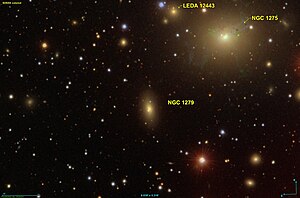NGC 1279
| Galaxy NGC 1279 |
|
|---|---|

|
|
| SDSS recording | |
| AladinLite | |
| Constellation | Perseus |
|
Position equinox : J2000.0 , epoch : J2000.0 |
|
| Right ascension | 03 h 19 m 59.1 s |
| declination | + 41 ° 28 ′ 46 ″ |
| Appearance | |
| Morphological type | S / S0? |
| Brightness (visual) | 15.0 mag |
| Brightness (B-band) | 15.8 mag |
| Angular expansion | 0.6 ′ × 0.4 ′ |
| Position angle | 0 |
| Surface brightness | 13.3 mag / arcmin² |
| Physical data | |
| Affiliation | Abell 426 |
| Redshift | 0.024300 |
| Radial velocity | 7285 km / s |
|
Stroke distance v rad / H 0 |
(330 ± 23) x 10 6 ly (101.2 ± 7.1) Mpc |
| history | |
| discovery | Johan Dreyer |
| Discovery date | December 12, 1876 |
| Catalog names | |
| NGC 1279 • PGC 12448 • 2MASX J03195907 + 4128462 • 2MASS J03195904 + 4128464 • LDCE 224 NED206 | |
NGC 1279 is a lenticular galaxy of the Hubble type S / S0? in the constellation Perseus in the north star sky . It is estimated to be 330 million light years from the Milky Way , has a disk diameter of about 60,000 ly and is part of the Perseus Cluster Abell 426 .
In the same area of the sky are u. a. the galaxies NGC 1274 , NGC 1275 , NGC 1277 , NGC 1283 .
The object was discovered on December 12, 1876 by the astronomer Johan Dreyer .
Web links
Commons : NGC 1279 - collection of images, videos, and audio files
